ralf | June 1, 2012 |
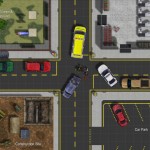 We are happy that we’ve been able to put out two new products last month. Together with the monthly Annual, I’ve got a triplet to announce.
We are happy that we’ve been able to put out two new products last month. Together with the monthly Annual, I’ve got a triplet to announce.
Symbol Set 3
The long-awaited and much delayed new version of Symbol Set 3 – Modern is now available. It comes with two completely new bitmap drawing styles for floorplans, with about 500 symbols each. One was created by Jon Roberts, the other by Michael Tumey. There is also a snazzy new blueprint-style for realistic looking player handouts, a Modern political overland style, and the old vector style has been updated to work with CC3’s sheet effects and drawing tools.
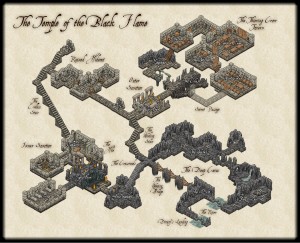
Tome of Ultimate Mapping
The second product is the Tome of Ultimate Mapping which has been updated by Remy Monsen (the author of the CC3 Full Manual) to cover Campaign Cartographer 3 and all version 3 products up to Fractal Terrains 3 (Dungeon Designer 3, City Designer 3, Symbols Sets 1 and 2, Cosmographer 3 and Fractal Terrains 3). The chapters on the other add-ons will be updated after their new versions are released. Symbol Set 3 is obviously the next on the list. You can see half a dozen example pages of the Tome here.
June Annual Isometric Dungeon Style
Last but not least is this month Annual Issue, an isometric dungeon style created by Herwin Wielink. I’m especially delighted with the lovely artwork in this issue and spent a whole evening just tinkering with the symbols, putting together a large example example map.
1 Comment
Clercon | May 16, 2012 | Annual, Campaign Cartographer, CC3, Overland map, Par lindstrom

I’ve started to play a simple and easy to understand roleplaying game with my two oldest children (this is also the reason that the names in the map are all in Swedish, they don’t read English). And of course no game can be really appreciated without a world map to look at.
So I decided to make one while trying out the April annual style from Profantasy, made by the artist Herwin Wielink.
It is always hard to start working with a new style, it takes a while just to get used to the style itself. What graphics are included, fields, desert, marshes, rivers, forests and so on. A good thing is to just create a couple of test maps to get used to the style, to get the feeling of it. In this case I did that, but not only on purpose. I’ve read on a lot of places that people complain that CC3 can be a bit unstable, that it sometimes crashes a lot.
Well I’ve never experienced that, apart from with one of my more ambitious projects where the actual file grew too large for CC3 to handle. But with this particular style I actually had two crashes where I had to restart the whole project from the start again. That has never happened before and it was probably just a coincidence that it happened now, but I guess that the end result ended up better because of this. You can say that I learned from the mistakes in the two earlier maps, so I didn’t need to repeat them in the final map. [Editor’s notice: If you ever lose your map, look for autosave.fcw in your CC3 folder.]
The graphics in the style are absolutely gorgeous and mountains, forests and other symbols really melt into the background in a great way that kind of hides the fact that the map is made in CC3. The only other CC3 style I can think of that accomplishes this as good as this one is the 2011 March annual overland style by Jonathan Roberts.
I also like the colour palette a lot in the style. Sometimes I think that maps made in CC3 can be bit cartoonish when it comes to colour, this particular style though has a really nice dark feeling about it. I like that.
Overall the style was very easy to use, the selection of textures and symbols are vast so you can really get some great variation into the map. And variation is very good if you want to make a map that is unique and nice to look at.
As usual I’ve done the labeling in Photoshop, I just can’t get it to work satisfactory in CC3, but that is probably because of me and not the program. The font is the same though as the one included in the style.
(Originally posted on mappingworlds.wordpress.com)
5 Comments
ralf | May 4, 2012 | cologne, convention, germany, rpc
 RPC Germany 2012 in Cologne
RPC Germany 2012 in Cologne
This weekend is Germany’s largest RPG convention in Cologne, the RPC Germany 2012 “Dark Waters”.
For the first time Profantasy will have a booth at that convention. Look for us in Hall 10, booth c-067. Come visit us and we’ll be happy to demo our software and answer any questions you might have.
Comments Off on ProFantasy at RPC Germany 2012
Clercon | May 3, 2012 | CD3, city, city planning, Par lindstrom, Tutorial
Originally posted on mappingworlds.wordpress.com
In this post we will create the outskirts of the city, farmlands and the ruins. First of all you have to decide what parts of the city that will be farmland and what part will be ruins. In this map I wanted to create the feeling that the city is situated in the middle of an old ruined city. The two closest islands to the east and west of the city will consist of farmland. Those areas are close to the city and will be easy to protect as well. On the north part of the western island you can also see that a part of the old city wall has been taken into use again, to protect the city from whatever hides outside.
When I create farmland I always start by putting in all the roads and houses. Usually you will have a cluster of houses just outside the city gates, the further away you get from the gates the more space you will have between houses. I then select the city hedge drawing tools and start to mark out the area where the fields will be. I’m actually using the same technique here as I do when I’m making smaller towns. For a more thorough explanation on how I draw the fields see my Mapping a small town part 4 post over at my mappingworlds blog.
When I’m done with all the fields the map looks like the picture below, so still some ruins to place.
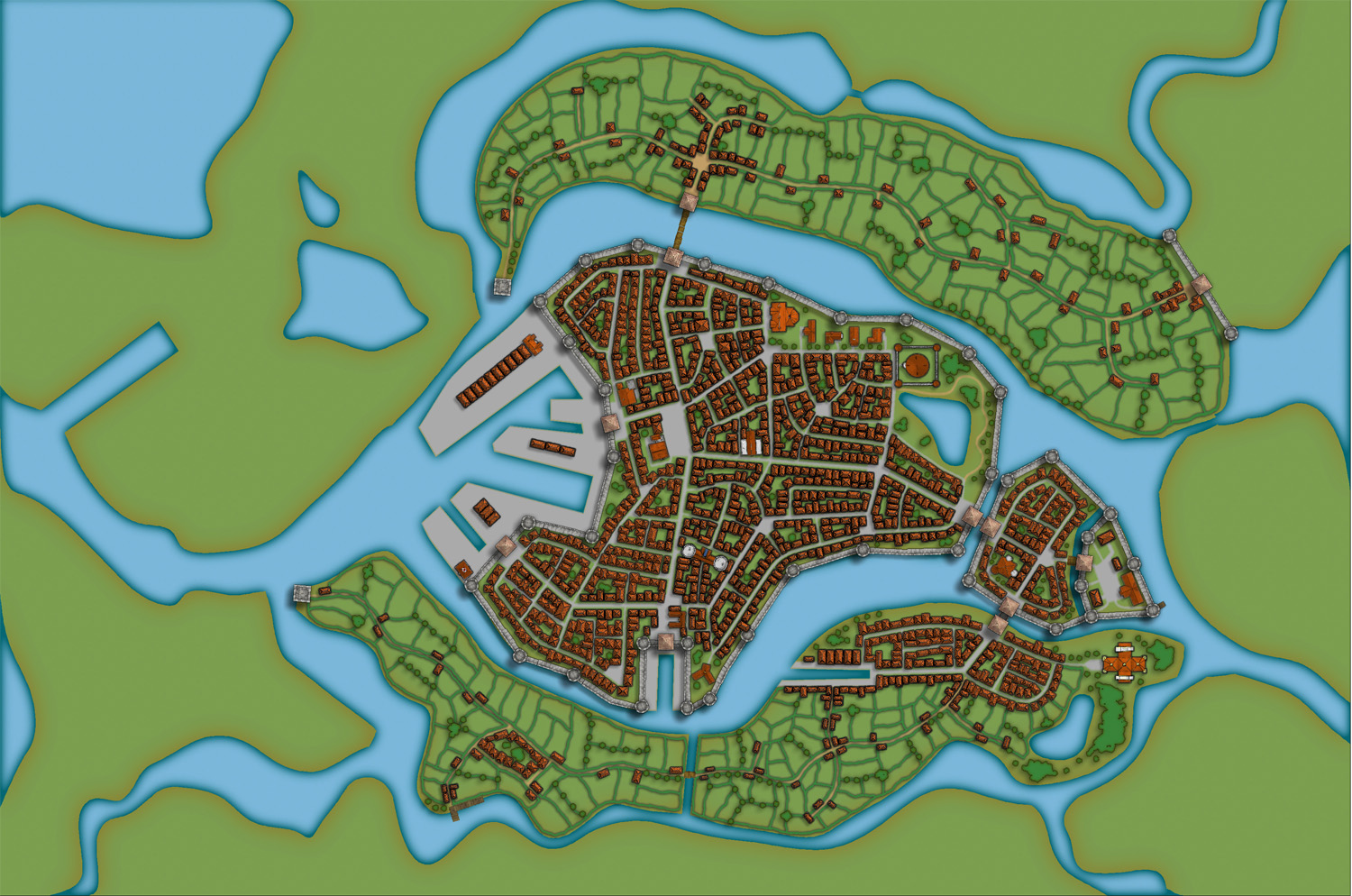
To complete the fields in the map I also export a map from CD3 where all the land is yellow. In this way I can combine them in Photoshop and paint in some yellow fields among the green ones. This will give you a more natural look than if the fields are just green. See my Mapping a small town part 6 post for more info on how to do this. The yellow version of the map looks like the picture below.
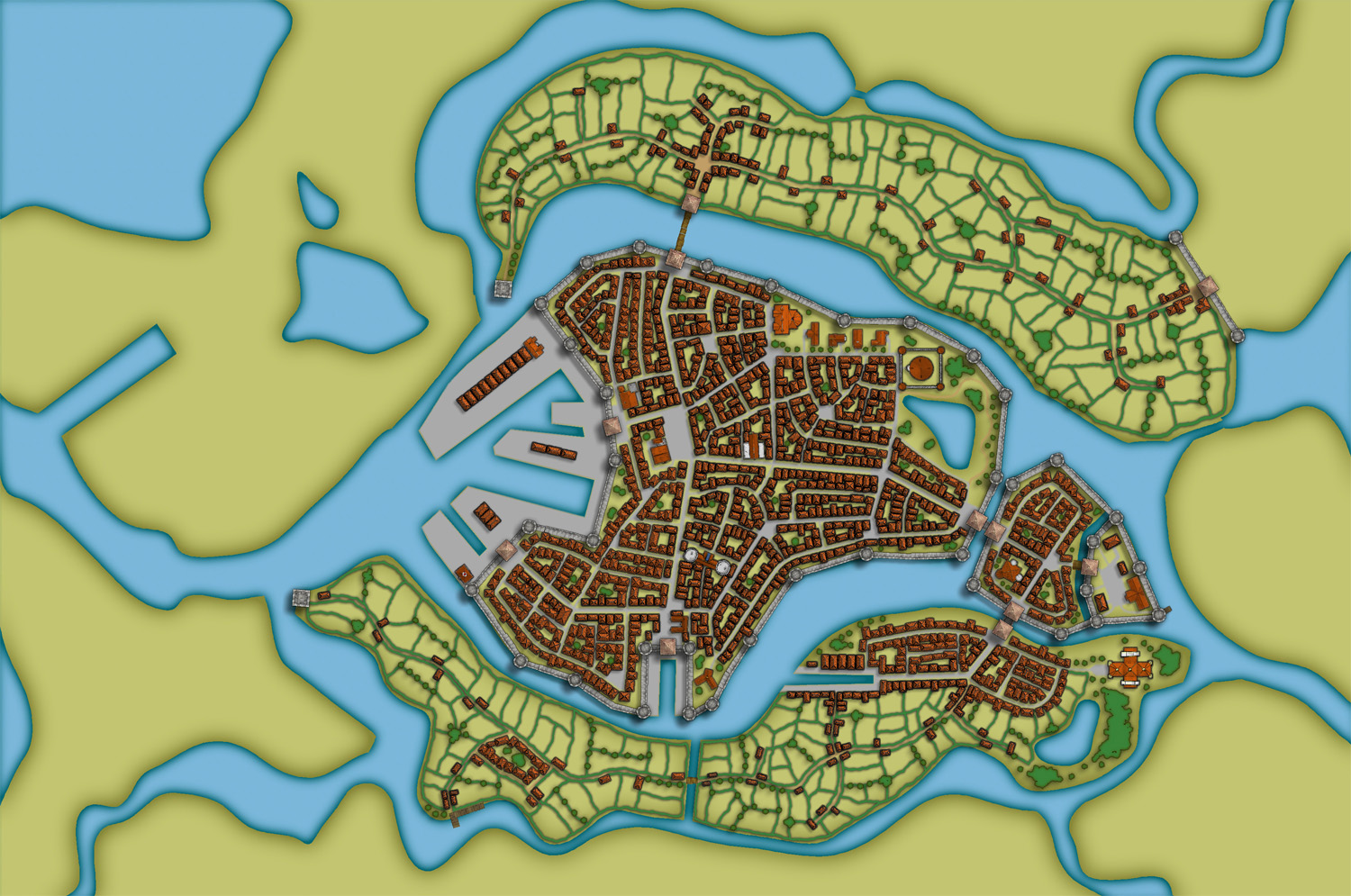
You can of course add in all the yellow fields in CD3, but I’ve found that to be a lot more time consuming then doing it by combining the two pictures above in a third party program. This program doesn’t need to be Photoshop, use the program that you feel comfortable with.
The next step would be to add in some ruins in the picture. Here I must say that CD3 didn’t really have any good styles to work with to get the look I wanted, so I had to make something up myself. Creating a completely new style wasn’t something I felt I had the time or knowledge to do, but I think a good ruined city style would be a great style add on in a future Annual. Sure you have some ruins in the program that you can use, but for me a ruined city mainly consists of the foundations of the houses and maybe some larger, more intact, buildings.
So I decided to draw in some random roads and houses using the CD3 B Ruins Grey buildings. They’re not perfect, but they are a good base symbol to continue working from.
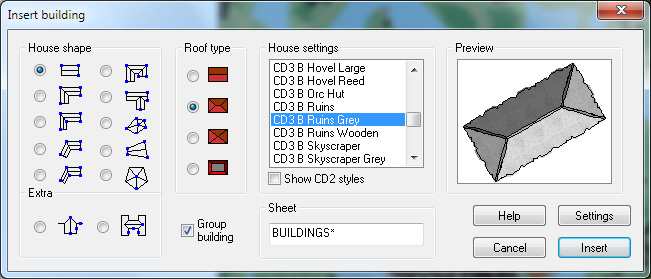
When I’ve put in all the roads and larger buildings in the map I’d export it again from CD3. This means that I now have three different versions of the map, which I’m going to put together in Photoshop, the two different ones with yellow and green fields and this one with a green background and ruins in the outskirts of the city.
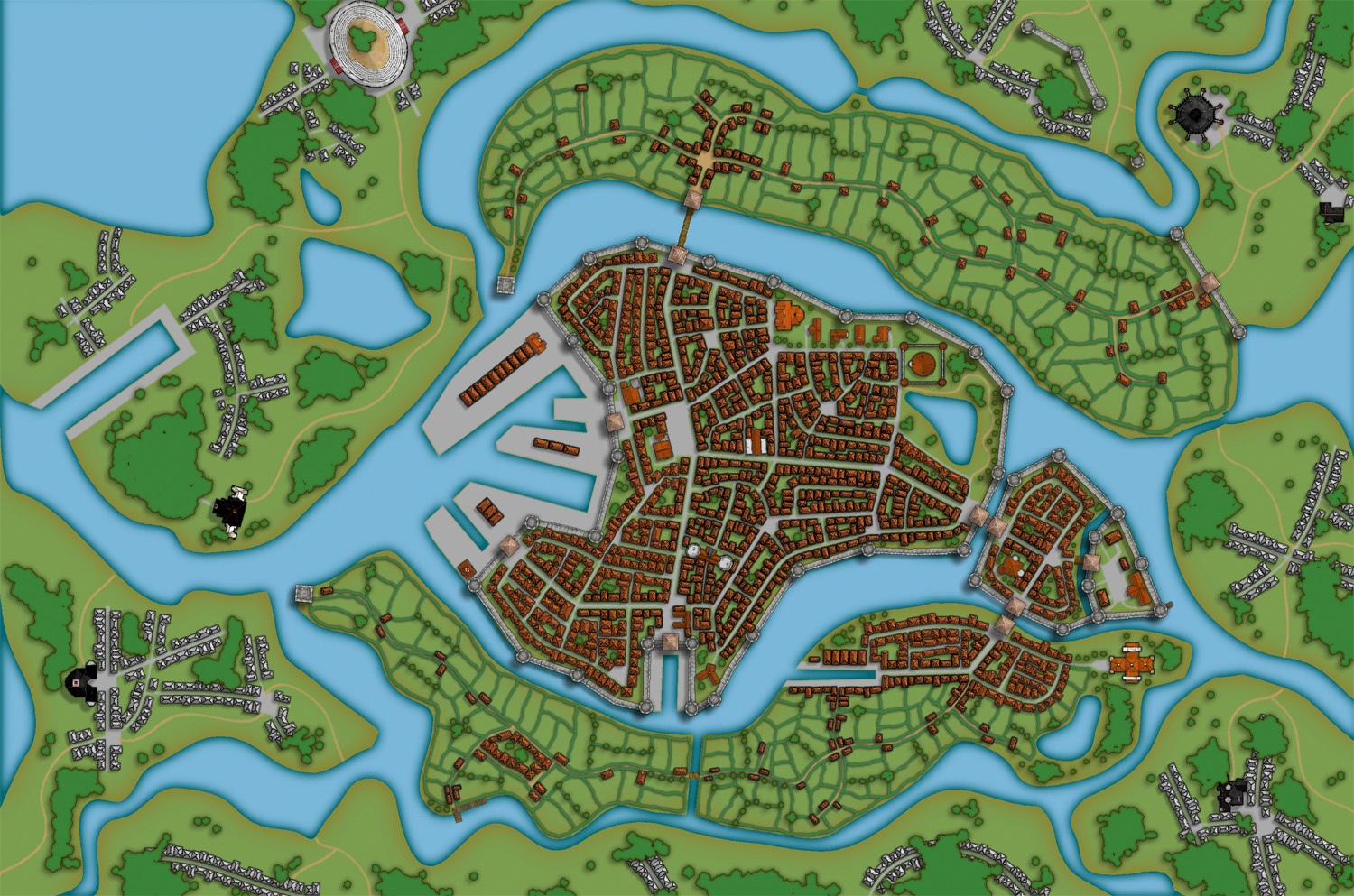
At this stage I had to work on the ruins a bit in Photoshop to make them look more like ruins. If you put the map with ruins in one layer and put it on top of a layer consisting of the map with green fields. You can start to erase bits and pieces from the top layer, when you do this the layer below will be visible instead of the top one. In this way I erased all the inner parts of the buildings, which left something that looked more like the foundation of a house. I also erased parts of the larger buildings to make them look more like ruins with broken roofs and missing walls.

In the picture above you can see a part of the map where you have the ruins as they look in CD3 on the left side, and how they turned out after some editing in Photoshop on the right side. In my opinion the right side looks more like ruins then the left side. Or at least more like the ruins I wanted in this particular map.
Making a City part 1
Making a City part 2
Making a City part 3
Making a City part 4
1 Comment
Simon Rogers | April 30, 2012 | overland
[Editor’s note: Forum member Mateus Buffone posts about his excellent Panorica map]
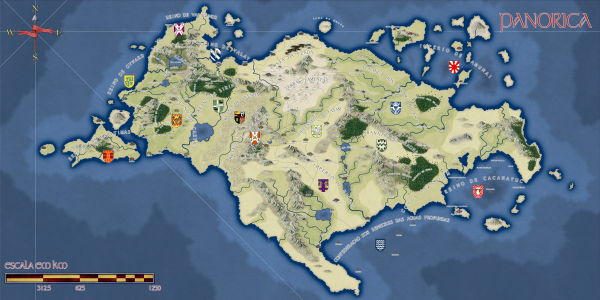 Some days ago Simon Rogers asked me if he could use my map as “The Map of The Month”. When I read it, I could not believe it. I started the hobby last year and I am still learning the tricks of the trade, so it’s an honor to have a map that I made posted.
Some days ago Simon Rogers asked me if he could use my map as “The Map of The Month”. When I read it, I could not believe it. I started the hobby last year and I am still learning the tricks of the trade, so it’s an honor to have a map that I made posted.
This map is named Continent of Panorica and I did the first version of it in less than an hour for a RPG game that I would begin on the next day. The first thing that I neded was a style that would fit well in a continet map and that have a “fantasy” feel, as what I wanted was a fast and “cliché” map for a fast and “cliché” world. So I choosed the CA51 Jon Roberts Overland Style that is part of the 2011 Annual.
I generated landmasses in Fractal Terrians 3 until I saw one that would fit my needs. Than I exported it to CC3 and fractalized a little more. After that I used the Land Default tool from the style and drew the islands, then used Fractalize on them to achieve a nmore natural feel. The next step was to place the mountains ranges. I was not concerned very much with realistic geology but I did not want to explain all my world with “magic!”, so I placed them first near the coast where I thought others continents would exist if I some day did the whole world. Then I placed the central chains as I needed a desert for my game. For the first version I only needed the central region so I placed some of the major rivers of the continent and dotted some settlements near the desert to form a pseudo-Arabian/tuareg region and called it a day.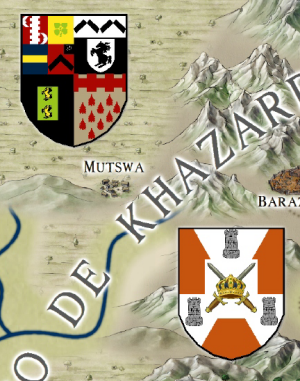
But at that point I was in love with the project and wanted to transform it in my fixed fantasy map for the kind of game that I was running (a GURPS Dungeon Fantasy campaign). So I needed other regions and more details. So I begin to really think about the whole image: what cultures lived there, their society and political organizations. I decided to made the banners of the diferent kingdoms and others political organizations. For it I used the CA15 “Heraldry” from Annual 2008 and exported then as FCW entities to my continent map. I used some symbols found on the Map & Catalog Library in the ProFantasy home page. First I had a lot of dificults to implement the shields because messing with sheets is not very easy, but when you learned what to put where they are a big time saver! For the desert, florest, farmland and scrubland terrain to work on this map I had to rescale then for just 50% of their original size (this tip was gave to me by Simon himself).
[To rescale a bitmap fill style:
1. Click on the Fill Styles Indicator, the Bitmap Fills tab, and find the texture on the Fill Style Name pulldown.
2. Reduce the Scale Width and Height (maybe to 50%) and OK.
3. Try again until it looks right.]
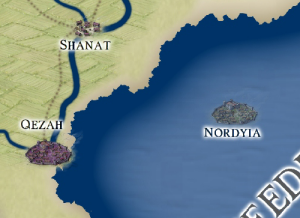 Another point of interest was the underwater setlements (Forte do Sino inside Terras Alagadas and the whole southeast region). I spend a big time with then and in the final I only neded of an Transparency effect. And I think that this is one of the most import aspects of CC3. When you find good effects and know how to create and manage sheets for each of your maps you can achieve very good results.
Another point of interest was the underwater setlements (Forte do Sino inside Terras Alagadas and the whole southeast region). I spend a big time with then and in the final I only neded of an Transparency effect. And I think that this is one of the most import aspects of CC3. When you find good effects and know how to create and manage sheets for each of your maps you can achieve very good results.
I hope that you like my map and if have any suggestion talk with me on the community.
6 Comments
jonasgreenfeather | April 27, 2012 | Cosmographer 3, Design Theory, Science Fiction, Space Opera, Starship Design
When I was 7-ish I walked into the living room where dad was watching a show about space ships, guys in primary colors and aliens, “What’s this?” “Star Trek, it’s about space.” he said, between the dialog. I sat down next to him quietly, completely transfixed, I remember, at the time, feeling really special that he’d share this with me. I’ve been pretty lucky with my parents: Mom gave me my love of all things Fantasy and from dad, Science Fiction. Because of him I’ve always loved drawing starships; exteriors, interiors, odd angles, you name it I’ve put it on paper somewhere. I’d like to share with all of you my process of creating a starship deck plan and elevation cross section, from the initial idea of the pen and ink sketch to the final completed render. I’ll be documenting the good and the bad (and the design dead-ends) with the hope that it inspires others to share their designs as well.
A science fiction cornerstone for any grand space opera, is a well-designed and believable vehicle for your PCs. A good ship design should get an emotional reaction from everyone who sees it.  If some minor planning takes place during the early stages of the design, your players will treat it like another character they encounter in their game: love it, hate it, mourn it when it’s gone. If you ignore a setting where your characters will spend a good portion of their campaign you risk the worst reaction of all: indifference.
If some minor planning takes place during the early stages of the design, your players will treat it like another character they encounter in their game: love it, hate it, mourn it when it’s gone. If you ignore a setting where your characters will spend a good portion of their campaign you risk the worst reaction of all: indifference.
Like every NPC, a well designed ship should (figuratively and literally) propel the plot forward while serving as a hub and safe haven; a place your players can catch their breaths and decide what action to take next. But, it should also fit into the story as well: Do you have a galaxy spanning mystery and need the best and brightest to solve it? A ship that encompasses human knowledge and understanding and aids its crew in accomplishing the mission at hand, like the Enterprise, fits the need nicely. What if your players discovered some unspeakable evil and a vehicle is needed to intensify the isolation and paranoia as they try and survive? The Ishimura (Dead Space) or Nostromo (Alien) are great examples of a design that works against the goals of its passengers. In the end, creating a good back story for your starship is as equally important as deciding where the engine and bridge belong.
What’s the need?
When it comes to designing a starship there are 3 basic roles that can describe any ship type you’ll need in your campaign:
1. Ships that carry stuff/people/aliens
2. Ships that look for stuff/people/aliens
3. Ships that want to blow-up stuff/people/aliens
That’s not to say you can’t have a ship that does more than one role (like a spaceship that looks for stuff and blows up stuff) but, by focusing on a single role in the beginning your boat design will be easier to flesh-out. If you look at any modern naval ship, for a contemporary example, you’ll find that these three roles are often mixed; the United States’ Navy’s Wasp class amphibious assault ship performs each of these roles very well:
Move a lot of Marines into battle, quickly (carry people)
It’s a small(ish) aircraft carrier (blow up people/stuff)
Support search and rescue/humanitarian missions (look for stuff)
The original design goal, get Marines on the beach quickly and once there support them so they don’t get killed, defines the need; the secondary roles it.
The first question you should ask yourself is: What will I need this ship to do? I’ve posted some small ships on the forum that already cover the look for stuff / blow up stuff roles and now, for this post I want to try a smaller carry people role troop transport…
What’s the story?
The next step is filling in the back-story of your ship, and this can be as detailed or as sparse as you need and want. Since I know I’ll be designing and building a troop transport, I now have to ask: How will it do that?
The idea of a large box packed full of soldiers slowly de-orbiting and dodging anti-aircraft fire seems to me, representative of a WWI mindset (Just keep charging that trench, boys! Eventually their trigger fingers will cramp, then we got ‘em!). Once again, this is not a bad idea; it’s just not how I want to design this ship. I want a ship that’s more nimble, marginally concerned with passenger comfort and safety, and if some damage is taken, not doom everyone.
I’ll also need to consider how many troops will be carried on board, once I decide this, filling out the remaining ship’s crew will be easier. Since I’ve decided to make this a smaller, company sized, troop carrier (about 140 soldiers) I’ll need to determine how to get them to the battle field.
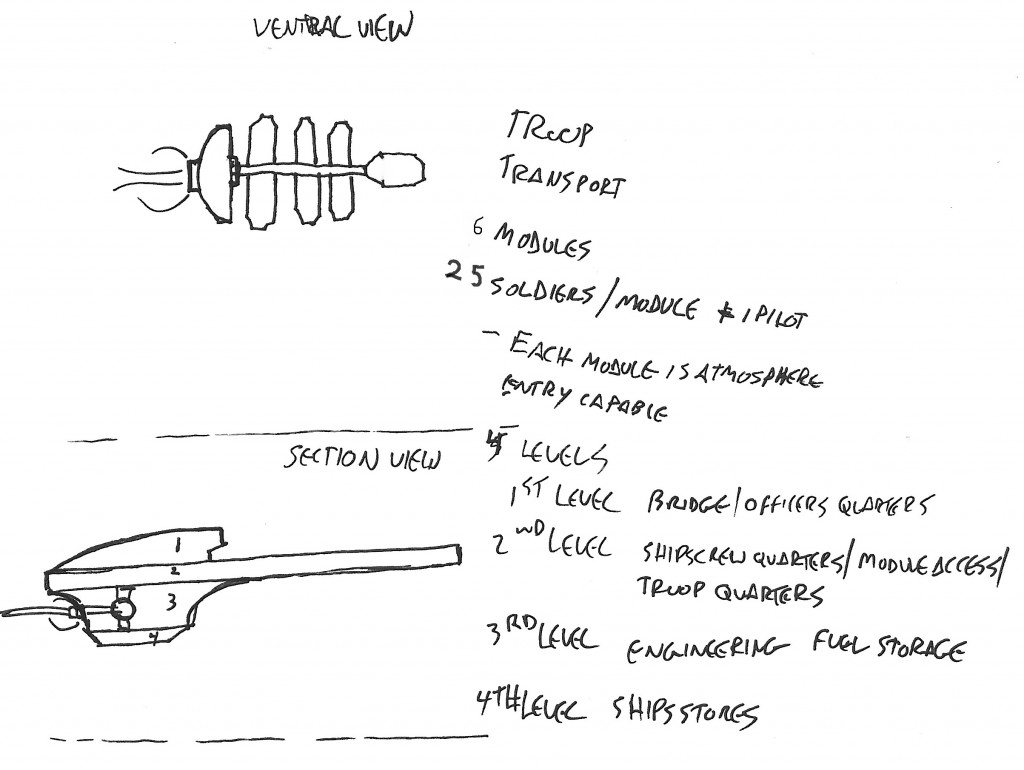 The final piece of this initial puzzle and the ship I’ll be designing is one that will get the drop ships to where they need to be. The (very rough) sketch to the left shows all the major details of the troop carrier, plus a few detail notes. This drawing shows a four level transport with six drop ships that attach to it along a central corridor.
The final piece of this initial puzzle and the ship I’ll be designing is one that will get the drop ships to where they need to be. The (very rough) sketch to the left shows all the major details of the troop carrier, plus a few detail notes. This drawing shows a four level transport with six drop ships that attach to it along a central corridor.
I like the image of fast entry orbital drop ships leaving trails of super-heated plasma as they tear through the sky, when they get to their LZ, anti-gravity engines kick in slowing their descent, the troops rushing out to meet their fates when they touch down.
I want to avoid the look of a modern aircraft carrier or the BSG, where ships are parked in an enormous internal hanger. If things get bad during an insertion and the hull is breached,… well, all hands lost. Part 2 will have us transfer the drawing into Cosmographer 3 and start to place points of interest like command and control, engineering, and living and work spaces.
Keep Calm
and
Map On
1 Comment
Clercon | April 16, 2012 | CD3, city, city planning, mapping cities, Par lindstrom
Originally posted on mappingworlds.wordpress.com
We now have the basic layout of the city. Next step is to put in more roads and try to decide where to place the majority of buildings. Sometimes when you create a large city the process of placing all the houses can be overwhelming. To make this easier I try to divide the city into smaller areas. I then place the houses one area at the time. In this way you divide the work into smaller goals that you can reach quite quick. It will make the whole process much easier. In the picture below you can see how I’ve divided the city of lost souls into seven areas to fill it with houses. Make every area interesting by adding a major house, villa or temple in it. It will add some details to your city and will make the end product more fun to look at.
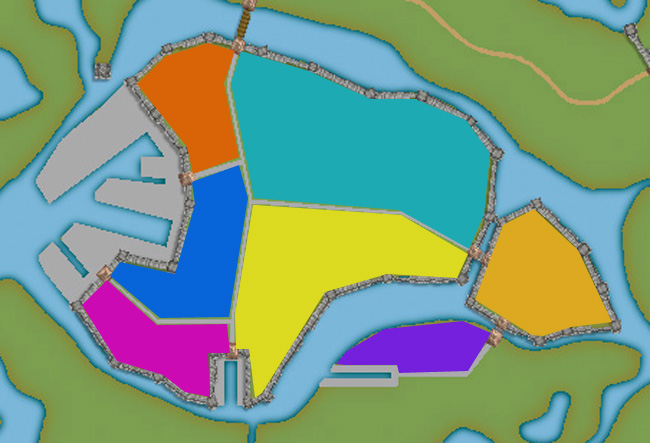
At this stage I also try to locate where the major squares will be, naturally they will be situated where the large roads meet up. I also like to add some smaller squares in front of the gates, usually this is where people have to wait to get in and out of the city. You also have to decide what density your city will have. Nearly all cities have some sort of park or green area, older cities could actually have quite a lot of farmland inside the walls. In this case how ever the farmlands are outside the city walls.
When I start to place the houses I zoom in and out to quite a lot to check the progress of the area I’m doing to make sure that the network of roads and houses looks natural. A good thing to think about is if the area you’re making is planned or if it has grown over time. To understand the difference in how a planned city looks compared to one that has grown over time you can look at some modern cities in USA (for example New York) and compare it to some older ones in Europe (for example Venice). The planned ones tend to have straight roads in squares and the grown ones usually have roads and city blocks in all kind of versions. At first you can’t really see any logic in the city construction, but after a while you will start to see that roads lead between squares and larger empty areas usually consist of an important building and its surroundings.
When I start to map an area I always start with the roads. First I add in some larger main roads, I then switch to a smaller road to make intersections between the larger roads. In the picture below you can see a nearly finished inner part of the city. I’m working on the last area and have put in the roads and squares. The squares I try to place in areas that feel natural. Also try to have some space between squares, a square is a place to meet and trade, so they will be evenly spread out in the city.
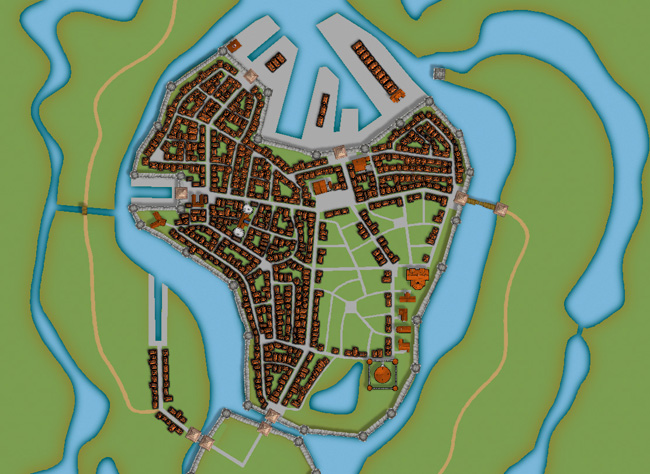
When I add houses to a city or town I always start by using the Random street tool. The ability to quickly add all houses on a street is one of City Designer 3′s best advantages. When you’ve added a lot of streets it isn’t always possible to use the Random street tool everywhere, in those cases I add the houses one by one. Sometimes you also have to go back after adding houses with the Random street tool and delete houses that don’t fit in for one reason or another.
When I use the Ramdom street tool I try to make the houses come as close to each other as possible. To do that you have to change the settings a bit. Right click on the Random street tool icon and in the street option window you click the Street settings button. The settings I used for the map you can see in the picture below.
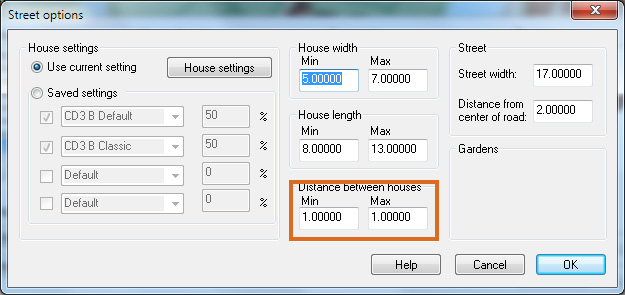
The most important setting is the Distance between houses that I always set to 1, both as Min and Max value. In this way you will get the houses as close as possible togehther. The other values depend on the scale of the map that you’re doing. You have to try some different settings here and see what works out.
When you’ve added houses to all your areas in the town you are done with the central parts of your city. Don’t forget to zoom out once in a while and check that the streets look good. I often have to go back and add some more roads to make the city more crowded. In the next post we will start on the outskirts of the city, farmlands and ruins.
Making a City part 1
Making a City part 2
Making a City part 3
Making a City part 4
Comments Off on Making a City part 3
Clercon | April 5, 2012 | CD3, city, city planning, mapping cities, Par lindstrom
Okay, so far we have the landscape where the city will be situated. When creating the City of the Lost I combined graphics from three different styles in City designer 3. First of all the actual landscape, which is what we have at the moment, is made in City style A. Later on when I add in houses I mainly use the graphics from City style B. The reason for this is that those houses looks more painted then the one in style A. which look more 3d generated. Which one to prefer is up to you, but in the maps I do the style B graphics are better suited. In this map I’m also using some graphics from the Profantasy March annual, Jon Roberts city style. In that style I’m especially fond of the city walls and towers. However the walls in this style are a bit harder to place due to being built from a static graphic file. So you have to watch the corners because they tend to create some gaps there. A good way to hide this is to place a tower on the “bad” spot.
When I start a new town I usually always start by building the town wall and deciding where the gates will be. In this way you will get a clear view and idea on where the majority of houses will be placed, so you can plan ahead and get a good balance in the map. In this particular map we also have three different docks, one larger and two smaller ones. In older cities the docks were often situated outside the city walls. In this way you could both tax the goods efficiently when they were entering the actual city and you also didn’t need to compromise the security of the town. So I’m placing the two docks on the central island outside the walls. The small third dock, however, is situated in an area where you have no walls. This dock is probably used for more local trading, not taking in ships from abroad. The idea with the docks is also that they are remnants from an earlier city that has been reused. So naturally it is around the docks that the “new” city is built.
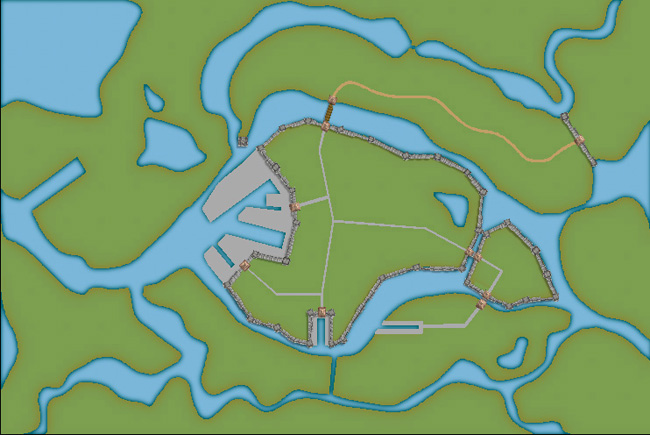
Now, when we have the walls and gates of the city I put in the main roads. The logic here is that all main roads in a city usually will take you from gate A to gate B. Somewhere in between you will have some main areas like a square or a city hall etc. In this way you will also create some natural boundaries for different districts in your city. It will make it easier for you to plan the next step, adding more roads and start adding houses.
Making a City part 1
Making a City part 2
Making a City part 3
Making a City part 4
Comments Off on Making a City part 2
ralf | April 1, 2012 | Annual, herwin wielink, overland
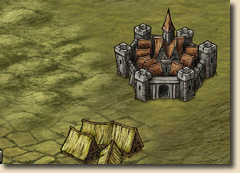 We’ve just made the April issue of the Cartographer’s Annual 2012 available. Enjoy a beautiful new overland style created by Herwin Wielink. It’s the first time you see his art in the Annual, but it won’t be the last!
We’ve just made the April issue of the Cartographer’s Annual 2012 available. Enjoy a beautiful new overland style created by Herwin Wielink. It’s the first time you see his art in the Annual, but it won’t be the last!
If you haven’t subscribed to the Annual 2012 yet, check out more information on this issue on the Annual website.
1 Comment
ralf | March 30, 2012 | Annual, artists, overland, wielink
Here’s a preview for Sunday’s upcoming Annual issue. Herwin Wielink‘s beautiful overland style:
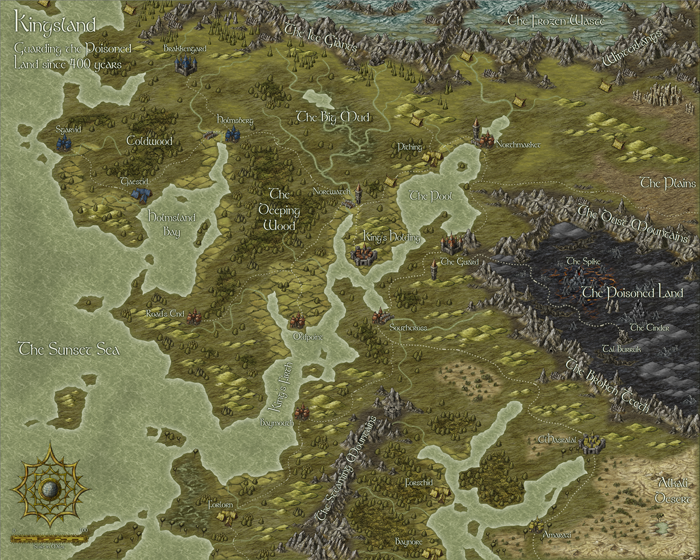
2 Comments
 We are happy that we’ve been able to put out two new products last month. Together with the monthly Annual, I’ve got a triplet to announce.
We are happy that we’ve been able to put out two new products last month. Together with the monthly Annual, I’ve got a triplet to announce.









 Another point of interest was the underwater setlements (Forte do Sino inside Terras Alagadas and the whole southeast region). I spend a big time with then and in the final I only neded of an Transparency effect. And I think that this is one of the most import aspects of CC3. When you find good effects and know how to create and manage sheets for each of your maps you can achieve very good results.
Another point of interest was the underwater setlements (Forte do Sino inside Terras Alagadas and the whole southeast region). I spend a big time with then and in the final I only neded of an Transparency effect. And I think that this is one of the most import aspects of CC3. When you find good effects and know how to create and manage sheets for each of your maps you can achieve very good results.






 We’ve just made the
We’ve just made the 